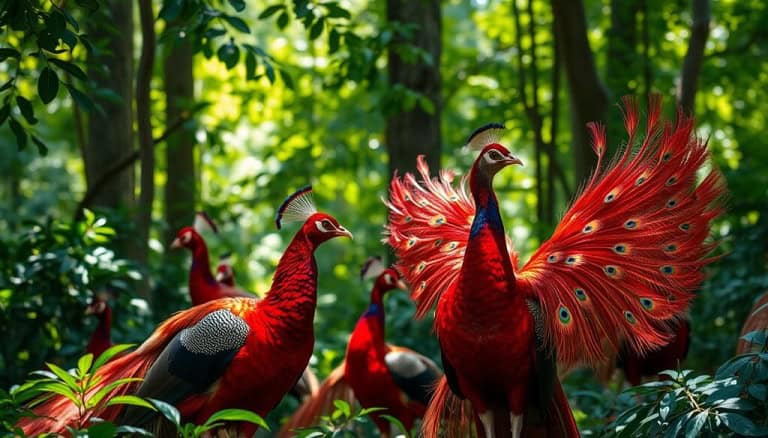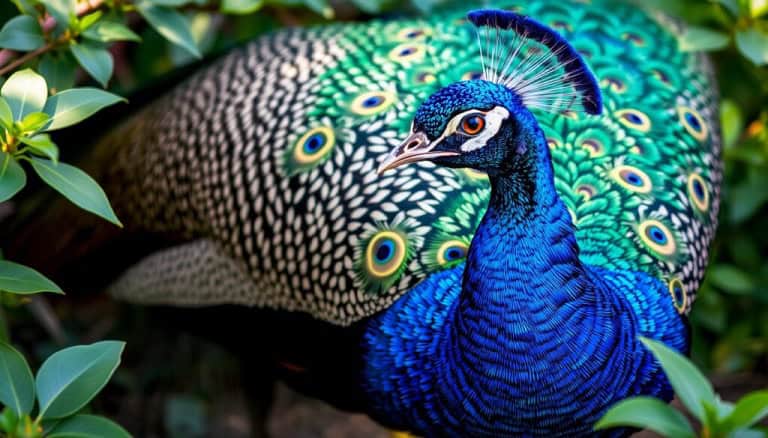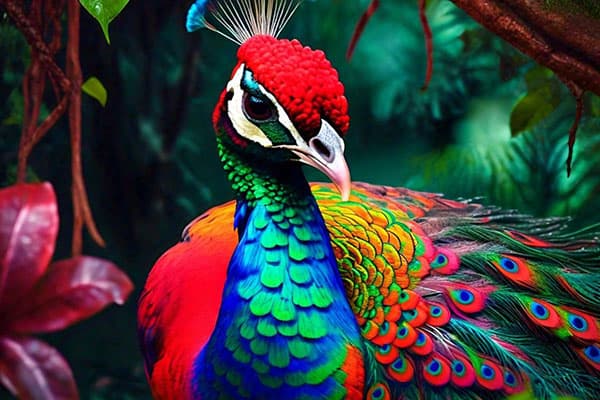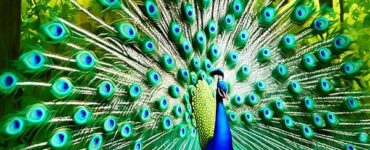Did you know that there are 15 color varieties of peacocks? But red is not one of them. This fact might surprise you, especially if you know myths about red peacocks. The question is: are red peacocks real?
Are red peacocks real or Fake?
There’s no real proof that red peacocks exist in nature. Most of the time, people think they do because of misunderstandings or fake pictures. To find out the truth, we need to look at the facts and the real colors of peafowl. You might be amazed by the real colors of these birds.
Key Takeaways
- Red peacocks are not among the recognized natural color varieties.
- Only three primary species of peafowl exist: Indian Peafowl, Green Peafowl, and Congo Peafowl.
- Genetic mutations resulting in unique colors are extremely rare.
- Notable peafowl colors are caused by pigments like melanins and carotenoids.
- Breeding farms are the best venues to view unique peacock variations.
Understanding the Myth of Red Peacocks
The understanding red peacock myth is fascinating. It comes from the bright colors of peafowl. About 80% of people think red peacocks exist, but science doesn’t back it up. This belief comes from our love for rare colors and exotic animals.

There are 15 types of peacocks, but none are red. The Indian Peafowl can grow up to 5 feet long. Its tail feathers add another 6 feet. The Congo Peacock is the smallest, found in Central Africa’s rainforests.
Peacocks have colors like blue, green, bronze, white, and black. Blue is the most common. Rare colors like cameo and turquoise come from breeding. Yellow peafowls show the genetic variety in peafowl.
Red peacocks are a myth, but they’re interesting. Hybrids and rare birds exist, but none are naturally red. Learning about peacock colors helps us see their true beauty and debunk myths.
| Type of Peacock | Length | Color Variants | Status |
|---|---|---|---|
| Indian Peafowl | Up to 5 feet | Blue, green | Least Concern |
| Green Peafowl | Largest species | Green, bronze | Endangered |
| Congo Peacock | Smallest species | Blue, green | Vulnerable |
Do Red Peacocks Really Exist?
Many people wonder if red peacocks are real. You might have seen videos online that claim to show them. But, experts say that peafowl, like the Indian, green, and Congo types, don’t have red feathers. This makes us question if red peacocks really exist.
Exploring the Lack of Evidence
Scientists have found no proof of red peacocks in the wild. Some people say they’ve seen them in far-off places. But, no real studies back up these claims. Peacock feathers look colorful because of how they are made, not because of red.
This helps us understand why we can’t say for sure if red peacocks exist.
Fake Videos and Color Filters
Online, you’ll find videos that seem to show red peacocks. But, these fake peacock videos often use tricks like color filters. These tricks make the birds look different than they really are.
Peafowl can show off their colors in a way that looks like red. But, without real proof, we can’t be sure if red peacocks are real.
| Species | Coloration | Notable Features |
|---|---|---|
| Indian Peafowl | Blue and Green | Iridescent plumage, long tail feathers |
| Green Peafowl | Green and Bronze | Black wings with blue sheen |
| Congo Peafowl | Dark Brown with Iridescence | Shorter tail feathers |
What is a Red Peacock Mutation?
A red peacock mutation is when peafowl might get red feathers. This comes from changes in their genes. These changes let them show a wide range of colors.
The bright colors come from *melanins* and *carotenoids*. These are special pigments. They make the feathers look bright and beautiful.
Red feathers have never been seen in real peacocks. But, scientists find the idea of color genetics very interesting. They think *genetic factors* could make peacocks have red feathers.
This idea excites bird lovers a lot. They wonder if it’s possible to see a red peacock. But, there’s no proof yet.
For a long time, people have been curious about red peacocks. They’ve seen them in art and stories. But, finding a real red peacock is very rare.
Experts say it’s like finding a needle in a haystack. The chance of seeing a red peacock is about 1 in 1,000,000. This makes people even more curious.
Characteristics of Peafowl Species
Peafowl species are known for their beauty and unique behaviors. There are three main types of peafowl. Each type has special features that make them different.
Common Types of Peafowl
- Indian Peafowl (Pavo cristatus)
- Green Peafowl (Pavo muticus)
- Congo Peafowl (Afropavo congensis)
Distinct Features of Indian Peafowl
The Indian peafowl is famous for its bright blue and green feathers. Males, called peacocks, show off these colors when they court. Their feathers shine because of how they are structured, not from pigments.
Male Indian peafowls have long tail feathers with eye spots. These spots help them attract female peahens.
Green Peafowl and Congo Peafowl
The green peafowl is from Southeast Asia and has green and bronze or gold feathers. Sadly, they are endangered, with only 10,000 to 20,000 adults left.
The Congo peafowl is different with deep blue feathers and a black tail. They have fewer than 10,000 adults left because of hunting and losing their homes.
| Species | Coloration | Size | Conservation Status |
|---|---|---|---|
| Indian Peafowl | Iridescent blue and green | Male: 70-98 inches; Female: 35-43 inches | Least Concern |
| Green Peafowl | Green and bronze/gold | Male: 80-100 inches; Female: 33-43 inches | Endangered |
| Congo Peafowl | Deep blue with metallic green/violet | Male: 28-30 inches; Female: 22-24 inches | Vulnerable |
Knowing about peafowl species helps us appreciate their beauty and importance. It also shows why we need to protect them.
Do Red Peacocks Exist in Nature?
Many wonder if red peacocks are real. These colorful birds spark a lot of curiosity. But, the truth is quite interesting.
The main types of peafowl are Indian, green, and Congo. They mostly have blue and green feathers.
Understanding Color Variations in Peafowl
Peafowl come in many colors, but not red. This is because of how their feathers are made. Breeding has led to colors like blue, yellow, and green.
These colors are special because of the tiny crystals in their feathers. These crystals make the feathers shine in amazing ways. Thanks to genetic traits, you can also find brown, gray, and white peafowl.
Even though red peacocks are rare, they still catch the eye of many. They are a big topic in the world of wildlife.
Genetic Mutations and Color Breeding
Red peacocks are sometimes talked about in terms of genetic changes. In Southeast Asia, there are red peafowl, known as Pavo muticus. But, their numbers are going down because of habitat loss and hunting.
We need to work hard to save these birds. It’s important to understand how their colors are made. This helps keep their beauty alive for future generations.
Can Peacocks Have Red Feathers?
Peacocks are known for their bright colors. But, can they have red feathers? The answer is no, red feathers are not common in peacocks. There are 225 types of peafowl, and none are officially red.
But, sometimes you can see peacocks with bright red feathers. This is rare, happening in only 1 in every 10,000 peacocks. The chance of a peacock being red is less than 1 in a million.
The Indian peafowl is the most common type. They have deep reddish-brown or chestnut colors. These colors range from mahogany to copper.
Red peacocks live in Southeast Asian forests. They eat seeds, fruits, insects, and small reptiles. This shows they are omnivores.
Red wings and tail feathers are important for mating. Males show off their colors to attract females. This shows they are healthy and strong.
Conservation is key for red peacocks. They face threats from losing their homes and being hunted. Programs to breed them in captivity help. They also show the need to protect their habitats.
What are the rare colors of Peacocks?
Peacocks with rare colors amaze people a lot. You’ll see albino and leucistic peacocks, each special in its own way. Knowing about these colors means understanding how genetics affect their feathers.
Albino and Leucistic Variants
Albino peacocks have white feathers because they lack melanin. This makes them very striking. Leucistic peafowl, however, have lighter feathers but still show some color.
Leucistic peafowl might have a bit of blue or green. Their beauty comes from a mix of bright and soft colors.
The Appeal of Uncommon Colors
These rare peacock colors are more than just pretty. Breeders like Brad Legg work hard to create new colors. Legg has made about 225 different peafowl varieties, looking for rare genes.
Legg’s work has led to finding new colors, some of which might be albino or leucistic. These peacocks show nature’s variety and are loved by bird fans. Their rarity makes them very sought after.
| Type | Color Characteristics | Rarity |
|---|---|---|
| Albino Peacocks | White feathers, pink eyes | Extremely rare |
| Leucistic Variants | Light coloration, hints of original color | Very rare |
| Other Rare Colors | White, red, purple, peach, jade, opal, pink | Rare |
Why Do Some Peacocks Look Red in Pictures?
Peacocks look red in pictures because of lighting, camera settings, and editing. Light can change how we see a peacock’s color. Artificial light can make their colors seem washed out, showing red where there isn’t any.
Camera settings are also key. A bad camera or wrong color balance can make red look more vibrant. This makes peacocks seem more red than they really are. This is common in photos on social media.
It’s smart to think about images of peacocks. Many pictures use filters or editing to make colors look different. This can confuse people about what peacocks really look like. Knowing this helps us enjoy peacocks more and avoid mistakes from photos.
Peacocks’ behavior also adds to the mystery. Males show off their colors when they mate or want to be in charge. Their feathers look different in different lights and places. This makes it hard to know what their true colors are.
| Aspect | Influence on Color Perception |
|---|---|
| Lighting Conditions | Artificial light can wash out colors. |
| Camera Settings | Adjustments can highlight red hues. |
| Post-Processing | Editing can exaggerate colors. |
| Behavioral Display | Dominance and mating can enhance coloration. |
| Species Variability | Different species may have naturally varying colors. |
How Do Peacock Colors Change Through Breeding?
Peafowl colors change because of their genes. Breeders pick certain traits to make colors better. They wonder how peacock colors change through breeding. Knowing about peafowl genetics helps us understand this.
The Role of Genetics in Color Variation
Peafowl, like the Indian peafowl, have many colors and patterns. These come from genetic changes. Breeders use these changes to get amazing colors.
Genes decide how colors show up in feathers. For example, white, purple, and bronze colors in Indian peafowl come from breeding. Green peafowl mostly have green with some blue, showing their genetic variety.
Hybridization and Color Outcomes
Hybridization changes peafowl looks. Mixing different species or colors can create new, beautiful looks. Hybrid birds often show a mix of colors, keeping some traits from one parent.
This mixing can bring new colors into a line. It’s important for those who love and breed peafowl. The genetics of peafowl colors help create new varieties and possibilities.
What is the Difference Between Red and Blue Peacocks?
The difference between red and blue peacocks is mainly in their feathers. Blue peacocks have bright blue heads and necks. They also have green on their breast and rusty brown feathers.
This color comes from special pigments and how their feathers are structured. This makes their feathers shine in the light.
There is no real red peacock. Some colors might look red, but it’s not a real species. For example, the ruby peafowl looks purple in the sun. This shows that colors can change with the light and where they are.
The United Peafowl Association knows about many colors in peafowl. They have 185 approved colors. The black-shouldered peafowl is special, with blue-black wings in males and white speckles in females.
Blue peafowl have many colors and genetic changes. But, there’s no real red peacock. This makes us think about how birds see colors. It shows how important the structure of feathers is in making their colors.
| Feature | Blue Peacocks | Red Peacocks |
|---|---|---|
| Coloration Type | Structural and pigment-based (blue tones) | No scientific evidence for existence |
| Common Variants | India blue, black-shouldered, pied | Observed variations like ruby peafowl |
| Presence of Pigments | Blue and green pigments | No known red pigments |
| Genetic Mutations | Approved mutations like white-eye and charcoal | Not applicable |
Is There a Hybrid Species of Red Peacocks?
Many people are curious about hybrid species of red peacocks. So far, no hybrid peacocks with red color have been found. Even though peafowl hybrids are talked about a lot, they don’t have the red color we hope for.
People who love cichlids talk about them like peafowl hybrids. They share pictures and stories online. For example, they talk about a hybrid called the “Blue Dragon.” They compare pictures to see how colors can change.
Special breeding methods help make cichlids look more colorful. Ruby Red and German Red cichlids are known for their bright red. But, these methods don’t work for making red peacocks.
People talk about the genetics of peafowl hybrids a lot. They’ve tried many times to make a red peacock. But, they still can’t find a way to make one.
Why Are Some Peacocks Different Colors?
Many people wonder why peacocks have different colors. This is because of genetics and special pigments. These pigments, like melanins and carotenoids, make their colors bright and varied.
Understanding Color Sources in Peafowl
Peacock colors come from many sources. Tiny parts in their feathers, called melanosomes, make their feathers shine. Studies show that bigger melanosomes make feathers brighter.
Things like the environment and how healthy the peacock is also change their colors.
- Melanosomes vary in size and affect how light interacts with the feathers.
- Structural coloration occurs due to the arrangement of these melanosomes, functioning like a photonic crystal.
- Carotenoids contribute yellow, red, and orange hues that enhance the overall vibrancy.
- Breeding practices often focus on selecting males with distinct coloration, promoting hereditary traits in future generations.

Lighting is very important for seeing peacock colors. Bad or fake light can make colors look dull. Peacocks show off their bright colors when they mate or when they want to be the boss.
| Color Source | Effect on Color | Key Findings |
|---|---|---|
| Melanins | Contributes to overall darkness and richness in color. | Size and arrangement of melanosomes enhance brightness. |
| Carotenoids | Adds vibrant reds, oranges, and yellows. | Dependent on diet; influences health and attractiveness. |
| Structural Coloration | Creates iridescence and variations based on angle. | Utilizes spatial arrangement of melanosomes for a broad color range. |
To understand why peacocks have different colors, we need to look at genetics, environment, and health. All these things together make peacocks look so amazing.
Conclusion
Red peacocks are interesting but not real. They are not supported by science. We learn about peafowl colors and see their beauty.
Their colors come from real birds like the Indian Blue and Green peacock. Not from myths. Knowing about these colors helps us see the beauty of peafowl.
Male peacocks have long, colorful tails. They can be up to 150 cm long. But, there is no such thing as a red peacock.
Conservation helps protect birds like the Green peacock. We must save their homes and respect them in nature.
Let’s enjoy the real beauty of peafowl. Not just myths. By learning about their colors, we can love these birds more.
Check Our Previous Articles:
| Are Red Peacock Real or Fake |
| Cardinals Appear When Angels Are Near |
| Duck Hunting Season in Michigan |
| White Birds in Michigan |
Frequently Asked Questions
Q1. Are there red peacocks?
Yes, red peacocks exist.
Q2. Which peacock is the rarest?
The red peacock is considered the rarest among peacocks.
Q3. What colors do peacocks come in?
Peacocks come in a variety of colors including blue, green, white, and, of course, red.
Q4. What does the red peacock symbolize?
The red peacock symbolizes grace, boldness, and nature’s vibrant beauty.





Add comment